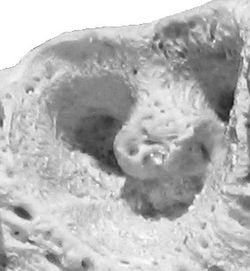| Dental alveolus | |
|---|---|
 Alveola of the second premolar tooth in a bovine maxillary bone | |
| Details | |
| Artery | Anterior superior alveolar arteries, posterior superior alveolar artery, inferior alveolar artery |
| Nerve | Anterior superior alveolar nerve, posterior superior alveolar nerve, inferior alveolar nerve |
| Identifiers | |
| Latin | alveolus dentalis |
| MeSH | D020390 |
| TA98 | A03.1.03.008 |
| FMA | 57490 |
| Anatomical terminology | |

Dental alveoli (singular alveolus) are sockets in the jaws in which the roots of teeth are held in the alveolar process with the periodontal ligament. The lay term for dental alveoli is tooth sockets. A joint that connects the roots of the teeth and the alveolus is called a gomphosis (plural gomphoses). Alveolar bone is the bone that surrounds the roots of the teeth forming bone sockets.
In mammals, tooth sockets are found in the maxilla, the premaxilla, and the mandible.
Etymology[edit]
1706, "a hollow", especially "the socket of a tooth", from Latin alveolus "a tray, trough, basin; bed of a small river; small hollow or cavity", diminutive of alvus "belly, stomach, paunch, bowels; hold of a ship", from PIE root *aulo- "hole, cavity" (source also of Greek aulos "flute, tube, pipe"; Serbo-Croatian, Polish, Russian ulica "street", originally "narrow opening"; Old Church Slavonic uliji, Lithuanian aulys "beehive" (hollow trunk), Armenian yli "pregnant"). The word was extended in 19c. anatomy to other small pits, sockets, or cells.
Socket preservation[edit]
Socket preservation or alveolar ridge preservation (ARP)[1] is a procedure to reduce bone loss after tooth extraction to preserve the dental alveolus (tooth socket) in the alveolar bone. A platelet-rich fibrin (PRF)[2] membrane containing bone growth enhancing elements can be stitched over the wound or a graft material or scaffold is placed in the socket of an extracted tooth.[3][4] The socket is then directly closed with stitches or covered with a non-resorbable or resorbable membrane and sutured.[5]
Pathology[edit]
The swelling of the dental alveoli can result in alveolitis, causing pain and discomfort to the mouth.
See also[edit]
References[edit]
- ^ Peck, Mogammad Thabit; Marnewick, Johan; Stephen, Lawrence (2011). "Alveolar Ridge Preservation Using Leukocyte and Platelet-Rich Fibrin: A Report of a Case". Case Reports in Dentistry. 2011: 1–5. doi:10.1155/2011/345048. ISSN 2090-6447. PMC 3335652. PMID 22567435.
- ^ Khiste, Sujeet Vinayak; Naik Tari, Ritam (2013). "Platelet-Rich Fibrin as a Biofuel for Tissue Regeneration". ISRN Biomaterials. 2013: 1–6. doi:10.5402/2013/627367. ISSN 2314-4025.
- ^ Tassos Irinakis, Rationale for Socket Preservation after Extraction of a Single-Rooted Tooth when Planning for Future Implant Placement, Journal of Canadian Dental Association 2006; 72(10):917–922
- ^ Fickl, Stefan; Zuhr, Otto; Wachtel, Hannes; Stappert, Christian F. J.; Stein, Jamal M.; Hürzeler, Markus B. (2008). "Dimensional changes of the alveolar ridge contour after different socket preservation techniques". Journal of Clinical Periodontology. 35 (10): 906–913. doi:10.1111/j.1600-051X.2008.01305.x. ISSN 0303-6979. PMID 18713258.
- ^ "Extraction socket preservation: The time is now" (PDF). Archived from the original (PDF) on 2014-07-14. Retrieved 2014-06-18.
External links[edit]
- National Institute of Health, CRISP Database
Well, that’s interesting to know that Psilotum nudum are known as whisk ferns. Psilotum nudum is the commoner species of the two. While the P. flaccidum is a rare species and is found in the tropical islands. Both the species are usually epiphytic in habit and grow upon tree ferns. These species may also be terrestrial and grow in humus or in the crevices of the rocks.
View the detailed Guide of Psilotum nudum: Detailed Study Of Psilotum Nudum (Whisk Fern), Classification, Anatomy, Reproduction